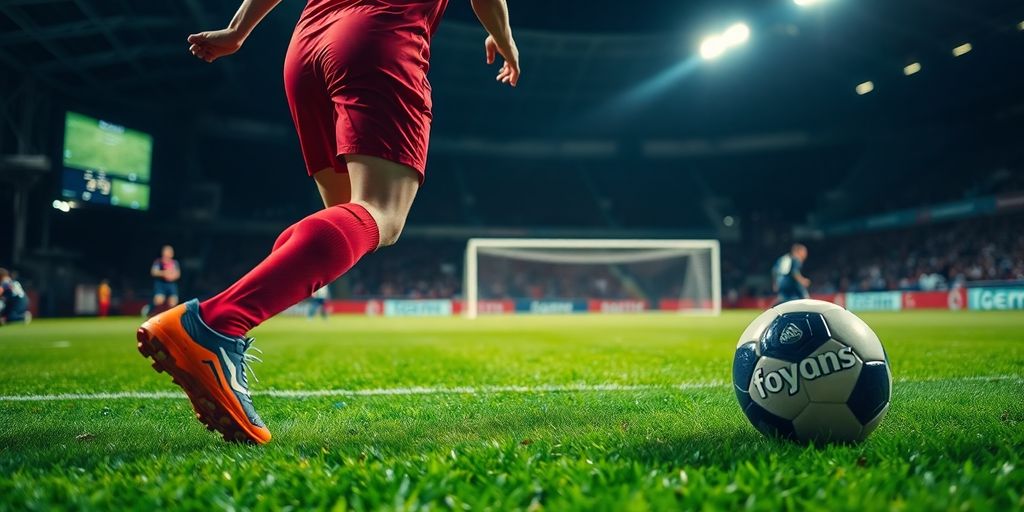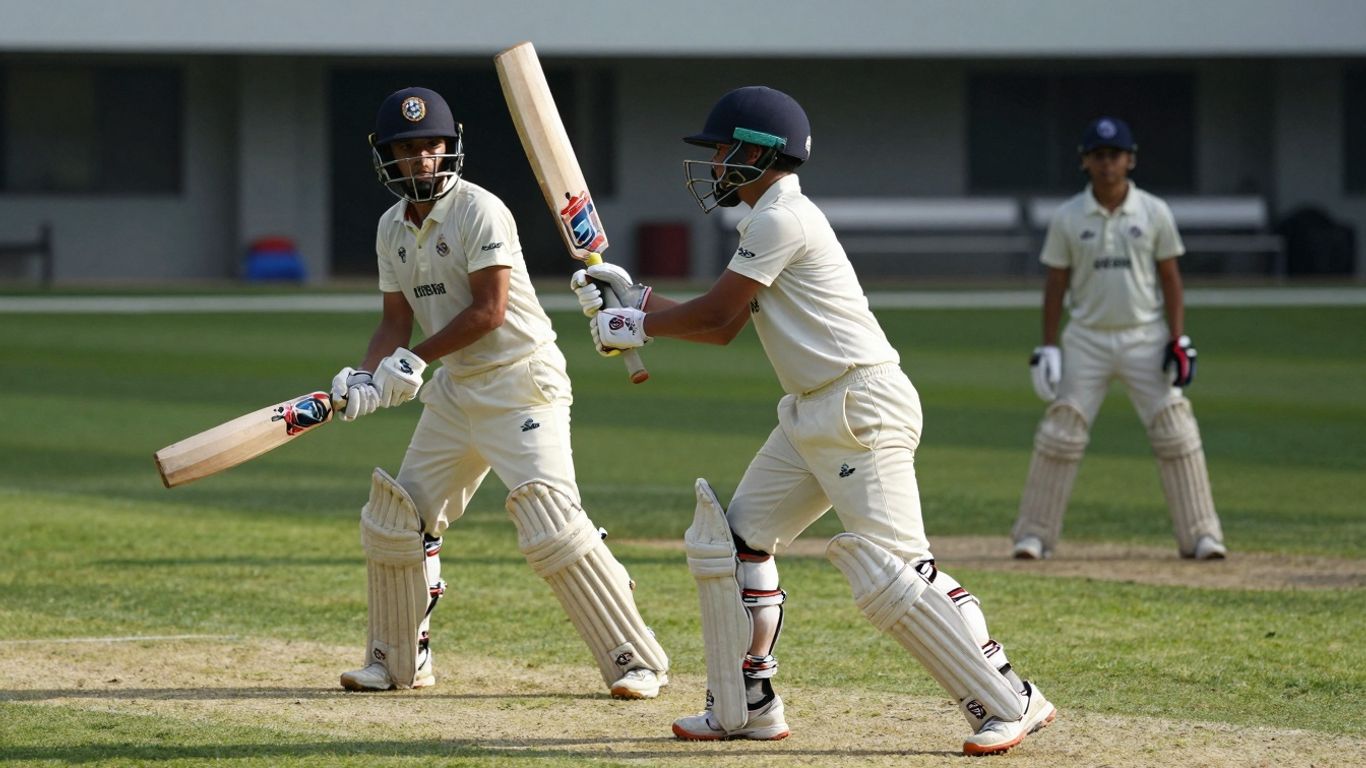Alright, so you’re keen on soccer, especially our Socceroos and Matildas, but that offside rule in soccer still throws you a bit? You’re not alone, mate. It’s one of those bits of the game that can confuse even the most seasoned fans. But don’t stress, we’re gonna break it all down, piece by piece, so you’ll be yelling at the telly with a full understanding of what’s going on. Let’s get stuck into the offside rule in soccer.
Key Takeaways
- A player is offside if they’re closer to the opponent’s goal line than both the ball and the second-to-last opponent when the ball is played to them.
- The offside rule in soccer has specific exceptions, like when the ball comes from a goal kick, throw-in, or corner kick, so no offside calls then.
- The assistant referees (linesmen) are super important for offside calls, using their flags to signal to the main referee.
- VAR (Video Assistant Referee) helps check offside decisions, especially the really close ones, which has changed how we see these calls.
- Remember, you can’t be offside in your own half, and just being in an offside position isn’t enough; you have to be involved in the play for it to be called.
Understanding The Basics Of The Offside Rule In Soccer
What Constitutes An Offside Position?
Alright, let’s break down what being offside actually means. It’s not as simple as just being past the last defender. A player is in an offside position if any part of their head, body, or feet is nearer to the opponent’s goal line than both the ball and the second-last opponent (usually a defender, but it could be the goalie if they’ve come way out). The hands and arms of all players, including the goalie, are not considered.
Think of it like this:
- You need to be past the second-to-last defender.
- The ball needs to be further upfield than you are.
- It’s only judged at the moment the ball is played to you by a teammate.
The Moment Of The Pass: Timing Is Everything
This is where things get tricky. The offside position is judged at the exact moment the ball is played by a teammate. It doesn’t matter where you were a second before, or where you end up a second later. If you’re offside when the ball leaves your teammate’s boot, you’re offside. This is why you see players making those darting runs, trying to time their movement perfectly to avoid being caught out. It’s all about spatial awareness and anticipation.
Interfering With Play Or An Opponent
Being in an offside position isn’t a crime in itself. You only get penalised if you’re deemed to be ‘interfering with play’ or ‘interfering with an opponent’. This can mean a few things:
- Playing or touching the ball after it’s been played by a teammate while you’re in an offside position.
- Obstructing an opponent’s line of vision or challenging them for the ball.
- Making an obvious action which impacts the ability of an opponent to play the ball.
Basically, if you’re offside and you’re actively involved in the play, you’re likely to be flagged. If you’re just standing there, not doing anything, you’re probably okay. It’s all about whether you’re gaining an unfair advantage from being in that offside position. The ref will consider if you are impacting the game or not.
Key Exceptions To The Offside Rule In Soccer

When Is Offside Not Called?
Alright, so you’re watching the game, and a player seems miles offside, but the flag stays down. What gives? Well, there are a few specific situations where the offside rule simply doesn’t apply. It’s all about understanding when the rule is active and when it’s not. These exceptions are designed to keep the game flowing and prevent the rule from becoming too restrictive.
Goal Kicks, Throw-Ins, And Corner Kicks
This is a big one. You can’t be offside directly from a set piece. That means if you receive the ball straight from a goal kick, a throw-in, or a corner kick, the offside rule is completely ignored. Think about it:
- A player can stand right next to the goal during a corner.
- A player can receive a throw-in even if they are past the last defender.
- A player can be past the last defender when the ball is kicked from a goal kick.
It adds a bit of spice to those situations, doesn’t it?
The Role Of Deliberate Play By A Defender
This is where things get a little bit murky, and even seasoned fans can get confused. If a defender deliberately plays the ball (think a pass, a header, or a controlled tackle), it can effectively ‘reset’ the offside position. However, a simple deflexion isn’t considered deliberate play. It’s up to the ref to decide if the defender meant to play the ball.
The key here is intent. If the defender is trying to make a play on the ball, even if it goes wrong, it can nullify an offside. This is one of those areas where VAR often gets involved, slowing the game down while they try to figure out what the defender was really trying to do. It’s a tough call, and it often leads to heated debate down at the pub after the game.
The Assistant Referee’s Crucial Role In Offside Calls

Assistant referees (or ‘linesmen’, as some of us still call them) are absolutely vital when it comes to enforcing the offside rule. They’re positioned along the touchlines, keeping a close eye on play to spot any potential infringements. Without them, the game would be in chaos, with players constantly trying to sneak offside. Their job is way more complex than just waving a flag; it requires intense concentration, a good understanding of the laws, and the ability to make split-second decisions under pressure.
Positioning For Accurate Offside Decisions
The assistant referee’s positioning is key to making accurate offside calls. They need to stay in line with the second-last defender (or the ball, if it’s closer to the goal line than the second-last defender) to get the best possible view. This isn’t always easy, especially with the speed of modern football. They have to constantly adjust their position as the play moves up and down the field, all while keeping an eye on the attackers and defenders. It’s a real test of their fitness and awareness.
Signalling Offside: The Flags Tell The Story
When an assistant referee spots a potential offside, they raise their flag to signal the infringement to the head referee. The way they raise the flag can also give the referee extra information. For example, the flag might be raised at a slight angle to indicate which player is offside or where on the field the infringement occurred. It’s a whole language of its own! The referee then decides whether or not to blow the whistle and stop play. Understanding soccer’s offside rule is vital for players and fans.
Communication With The Head Referee
Assistant referees don’t just wave flags; they also communicate with the head referee using a headset. This allows them to provide additional information about the offside, such as whether the player was actively interfering with play or gaining an advantage from being in an offside position. This communication is super important, especially in tight games where every decision matters. It helps the referee make the most informed decision possible, even under immense pressure.
The assistant referee’s role is not just about spotting offsides. They also assist with other decisions, such as throw-ins, corner kicks, and goal kicks. They’re an extra set of eyes for the referee, helping to ensure that the game is played fairly and according to the rules.
Here’s a quick rundown of the assistant referee’s responsibilities:
- Signalling offside offences.
- Indicating when the ball is out of play.
- Awarding throw-ins, corner kicks, and goal kicks.
- Advising the referee on other infringements that they may not have seen.
How VAR Impacts The Offside Rule In Soccer
The Introduction Of Video Assistant Referee
VAR, or Video Assistant Referee, has well and truly changed the game, hasn’t it? It was brought in to try and stamp out the howlers, those clear and obvious errors that refs sometimes miss. For offside, it means another set of eyes are checking the play, using cameras and fancy tech to see if a player was really off. It’s meant to bring more accuracy, but it’s also brought its fair share of drama and delays. It’s a bit like having a second umpire in cricket, but with replays and slow-mo. The goal is fairness, but the execution… well, that’s another story. It’s supposed to be used for VAR validation.
Reviewing Tight Offside Decisions
This is where VAR really gets its workout. Those super-close calls, where you can’t tell with the naked eye if a player’s toenail was offside? VAR can zoom in and draw lines to make the call. It’s all about precision, but that precision can also be frustrating. We’re talking millimetres sometimes, which makes you wonder if it’s really in the spirit of the game. It’s a far cry from the old days when the linesman just had to make a quick judgement. Now, every goal celebration has that little bit of hesitation, that nervous glance at the screen, waiting to see if VAR is going to spoil the party.
Controversies And Clarifications With VAR
Oh boy, where do we start? VAR hasn’t exactly been controversy-free. There have been plenty of debates about how long it takes to make a decision, whether the right angles are being used, and if it’s sucking the joy out of the game. Some decisions seem to take forever, and you’re left wondering if the delay is worth it. Plus, there’s the whole ‘clear and obvious error’ thing. What one person thinks is clear, another might not. It’s led to some pretty heated discussions down at the pub, that’s for sure.
VAR was supposed to eliminate controversy, but it seems to have just shifted it from the referee’s on-field decision to the VAR’s interpretation of the video. It’s a different kind of argument, but an argument nonetheless. And sometimes, you just wish they’d stick with the original call and let the game flow.
Here are some common complaints:
- Lengthy delays disrupting the game’s flow.
- Inconsistent application of the technology.
- Debate over what constitutes a ‘clear and obvious error’.
Common Misconceptions About The Offside Rule In Soccer
Offside In Your Own Half: A Myth Debunked
Right, let’s get this straight once and for all: you cannot be offside in your own half. It’s a common thing you hear down at the pub, but it’s simply not true. The offside rule only applies when you’re in the opposition’s half of the pitch. So, if a player is standing way upfield in their own half, waiting for a long ball, they’re perfectly fine. The moment they cross that halfway line into the attacking half, though, that’s when the offside rule kicks in.
Passive Offside: Understanding Non-Interference
Passive offside is where things get a bit tricky. A player can be in an offside position, but not actually be interfering with play. This means they’re not:
- Touching the ball
- Blocking an opponent’s line of sight
- Making a play on the ball
If a player is in a passive offside position, the ref won’t blow the whistle. They have to become ‘active’ to be penalised. It’s all about whether they’re gaining an unfair advantage from being in that position. Understanding non-interference is key to grasping this concept.
The ‘Last Defender’ Versus The ‘Second To Last Opponent’
This is another point that trips people up. It’s often said that a player needs to be behind the ‘last defender’ to be onside. That’s not quite right. The rule actually states that a player needs to be behind the ‘second to last opponent’ (or the last defender if the keeper has come way out of their goal). This is because the goalkeeper is usually considered one of the opponents. So, if there’s only one defender between you and the goal, and that defender is the keeper, you’re offside. It’s a subtle difference, but an important one to remember when analysing attacking strategies to beat the offside line.
Tactical Implications Of The Offside Rule In Soccer
The offside rule isn’t just some annoying law that ruins goal celebrations; it’s a massive part of how teams strategise and play the game. It dictates player positioning, attacking runs, and even defensive setups. Understanding its tactical implications is key to appreciating the beautiful game, mate.
Playing The Offside Trap: A Risky Strategy
The offside trap is a high-risk, high-reward defensive tactic. It involves defenders moving up the pitch in unison to catch attacking players in an offside position. When executed perfectly, it can shut down an attack before it even begins. But if mistimed, it leaves acres of space for the opposition to exploit. It’s a real gamble, and you’ll often see teams get burned by it. It requires perfect timing, communication, and a bit of luck.
Attacking Strategies To Beat The Offside Line
To counter the offside trap, attackers need to be smart about their runs. Here are a few strategies:
- Timed Runs: Players need to time their runs perfectly, starting from an onside position and only moving forward when the ball is played. This requires great anticipation and coordination with the passer.
- Checking Runs: Making a short run towards the ball before quickly spinning and running in behind the defence can catch defenders off guard and create space.
- Deep-Lying Forwards: Having forwards who drop deep to receive the ball can drag defenders out of position, creating gaps for other attackers to exploit. This can help to create attacking opportunities.
The offside rule forces attackers to think about their positioning and timing, adding a layer of complexity to the game. It’s not just about being fast; it’s about being smart and coordinated.
The Impact On Player Movement And Spatial Awareness
The offside rule has a huge impact on how players move and perceive space on the pitch. Players need to constantly assess their position relative to the ball, the defenders, and their teammates. This requires a high level of spatial awareness and decision-making. It also affects the types of passes that are attempted. Players are less likely to try risky through-balls if they think a teammate is in an offside position. The offside rule encourages shorter, safer passes and more intricate build-up play. It’s all about team synergy and understanding each other’s movements.
The Evolution Of The Offside Rule In Soccer
A Brief History Of The Offside Law
Right, so the offside rule hasn’t always been what it is today. Back in the day, it was way more strict. Imagine needing three players between you and the goal when the ball was played! Bonkers, I know. It was introduced to stop players just hanging around the opposition’s goal, waiting for a tap-in. Over time, they realised it was a bit too restrictive and started tweaking it to make the game more attacking. It’s a constant balancing act between keeping things fair and letting the game flow. The original offside rule aimed to prevent "goal lurking", but it severely limited attacking play.
Changes And Adaptations Over The Years
Okay, so the offside rule has gone through more changes than I’ve had hot dinners. Seriously, it’s been a rollercoaster. From needing three players to only needing two, to the introduction of ‘interfering with play’, it’s been constantly evolving. These changes were all about making the game more exciting and less stop-start. Referees have had to keep up, and so have we fans! It’s all about trying to find that sweet spot where the game is fair, but also allows for some attacking flair. Here’s a quick look at some key changes:
- Early Days: Three defenders needed between attacker and goal.
- Later: Reduced to two defenders.
- Modern Era: ‘Interfering with play’ becomes a key factor.
The constant changes to the offside rule reflect a desire to balance defensive structure with attacking opportunities. It’s a testament to the ongoing effort to refine the beautiful game.
Future Considerations For The Offside Rule
So, what’s next for the offside rule? Well, there’s been talk about all sorts of things. Some people reckon we should scrap it altogether, which sounds pretty wild. Others think we need even more tech to make the calls more accurate. The big question is, how do we keep the game fair and exciting without turning it into a video game? It’s a tough one, and I reckon we’ll see even more changes in the years to come. Maybe even robot referees, who knows! Here are some potential future directions:
- Automated Offside Technology: More precise line calls.
- Abolishing Offside: A radical change to encourage attacking play.
- Further Refinements: Tweaks to the ‘interfering with play’ definition.
Wrapping It Up: No More Head Scratching!
So, there you have it, folks. The offside rule, it’s a bit of a beast, isn’t it? But hopefully, after all this, it makes a bit more sense. It’s not just about where a player is standing; it’s about when the ball is kicked, who’s involved, and if they’re actually doing anything to mess with the play. It can still be a bit tricky, even for the pros, and sometimes the refs get it wrong. But that’s footy, right? It keeps things interesting. Next time you’re watching the Socceroos or your local club, you’ll be able to spot an offside call a mile away. You might even impress your mates with your newfound knowledge. Good on ya!
Frequently Asked Questions
Can a player be offside in their own half?
Nah, you can’t be offside if you’re in your own half of the field. The offside rule only kicks in when a player is in the opponent’s half.
Why do we even have the offside rule in soccer?
The offside rule is there to stop players from just hanging around near the opponent’s goal, waiting for a pass. It makes the game fairer and more exciting, encouraging proper teamwork and build-up play.
What’s the basic idea of being offside?
A player is offside if they’re closer to the opponent’s goal line than both the ball and the second-to-last opponent when the ball is passed to them. Simple as that!
Does offside apply to throw-ins or corner kicks?
Nope, not at all! Offside doesn’t apply during goal kicks, throw-ins, or corner kicks. You can be as far forward as you like in those situations.
How does VAR help with offside calls?
VAR, or Video Assistant Referee, helps the main ref check those super close offside calls. They look at replays to make sure the decision is spot on, especially for goals or big moments.
Who makes the offside call during a game?
An assistant referee, also known as a linesman, runs along the sideline and uses their flag to signal when they think a player is offside. They’re the first ones to spot it.





